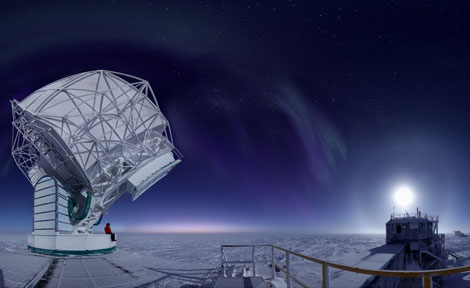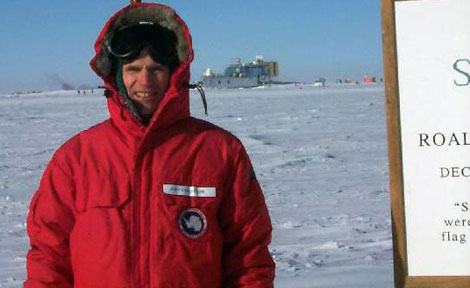South Pole's Next Generation of Discovery
(Originally published by the University of Chicago)
January 26, 2016

Later this year, during what passes for summer in Antarctica, a group of Chicago scientists will arrive at the Amundsen–Scott South Pole research station to install a new and enhanced instrument designed to plumb the earliest history of the cosmos.
It will have taken the combined efforts of scientists, engineers, instrument builders, and computer experts at UChicago, Argonne National Laboratory, Fermilab, as well as institutions across the world that participate in the South Pole Telescope collaboration.
“It’s a really technically challenging scientific project,” says Fermilab Director Nigel Lockyer, “and you couldn’t do it without the national labs’ expertise and enabling technical infrastructure.”
Led by John Carlstrom, the S. Chandrasekhar Distinguished Service Professor in Astronomy and Astrophysics and the Deputy Director of the Kavli Institute for Cosmological Physics (KICP), the South Pole Telescope is a global collaboration of more than a dozen institutions. It probes the cosmic microwave background—the radiation that remains from the Big Bang—for insight into how the universe has evolved and the processes and particles that have participated in that evolution.

“The physics of the early universe was imprinted into patterns in the cosmic microwave background that we can measure,” says KICP member Clarence Chang, who heads Argonne’s part of the project—the design and fabrication of the detectors. “But it is very faint, so we need a very sensitive camera.”
A new ultra-sensitive camera is both the heart of the telescope and the focal point of the collaboration between Argonne, Fermilab, and Chicago.
“UChicago is the scientific lead,” says KICP member Bradford Benson, an associate scientist and Wilson Fellow at Fermilab who directs the design of the camera and its integration with cryogenics, detectors, and electronics. “Fermilab provides expertise and resources at the integration level: How do we build this thing, package it, and operate it for many years? And Argonne has micro-fabrication resources that aren’t available elsewhere.”
The South Pole Telescope project is one of multiple collaborations among UChicago, Argonne, and Fermilab scientists. Others include experiments that examine the nature of neutrinos; as well as those including future accelerator science and technology.

The camera on the South Pole Telescope is made of an array of superconducting detectors that are sensitive to the frequencies associated with the CMB. Each requires depositing ultra-thin superconducting materials with dimensions as small as about 10 x 50 microns (50 microns is the approximate width of a human hair). These delicate detectors are built at Argonne, using the state-of-the-art facilities at the Center for Nanoscale Materials and materials developed in the lab’s Materials Sciences Division. The new focal plane uses integrated arrays of detectors on 150 mm silicon wafers, with ten of these modules making up the heart of the camera.
“They’re actually detecting the photons from 14 billion years ago,” Chang says. “They heat up the detectors a tiny bit, and then we measure that heat.”
The finished detector array modules go to Fermilab, where they are packaged and connected with the electronics for testing in the lab’s Silicon Detector Facility—a thornier task than it sounds. Each module requires thousands of hair-like wires to be connected individually to cable. Fermilab has specialized wire bonders that are accomplish this task, says Benson.
Then the assembly goes to the University of Chicago, where it is tested at a quarter of a degree above absolute zero—the temperature required for the superconducting detectors to be able to sense the tiny amount of heat from the incoming photons. The test results are then fed back to Argonne for adjustments to be made for the fabrication of the next modules. Ultimately everything winds up back at UChicago, to be integrated into a 2,000-pound camera to ship to the South Pole.
The new camera will have 16,000 detectors—a major upgrade from the 1,600-detector camera currently on the telescope. The scientists will use the increased sensitivity to search for the signature of primordial gravitational waves that an inflationary universe would have generated early in its history. A detection would probe physics at the enormous energies that existed when the universe was only a fraction of a second old—complementary to the studies at the energy scales of the Large Hadron Collider.
The new camera also will enable them to obtain precision measurements that will help determine the mass of neutrinos, so-called ghost particles that were created in huge numbers shortly after the university began and which contribute significantly to its evolution.

Making 16,000 of anything isn’t something universities typically do.
“People are often trying to make one device, understand the physics of it, and publish a paper on it,” says Benson. “We’re trying to build these instruments that are on a much larger scale, and they need to be mass produced. There’s not much of a technical staff or infrastructure at a university to maintain something like that on a five or 10-year time scale. Argonne has built up that expertise. And we can plug into that.”
Chang, Benson, and Carlstrom have collaborated on the SPT project for more than a decade. They have worked to create as seamless a process as possible so that scientists, postdocs, and students can go back and forth between groups with no bureaucratic barriers. Both Chang and Benson have part-time appointments at the University, which helps.
“The collaboration lets us do more than what we could ever do otherwise,” says Chang. “We’ve cultivated the ability to have a single group of 20 or 30 people. You’ll never have a group in a university or at either of the labs that is that big. There’s a critical mass, intellectually, that emerges from that. I think that’s the biggest thing that we get out of this. And that’s something that’s hard to find elsewhere, either at other labs or at other universities.”
Although the new telescope isn’t yet installed at the South Pole, the project partners are already looking ahead to the next, more sensitive telescope.
“A project the size of the fourth-generation South Pole Telescope requires grand collaborations,” said Argonne Director Peter Littlewood. “In order to build, install, and operate an instrument with half a million sensors, we are investing in a multi-institution combination of strong project management and state-of-the-art physical infrastructure to create something truly extraordinary for science.”